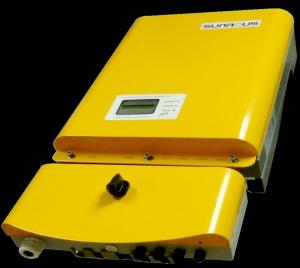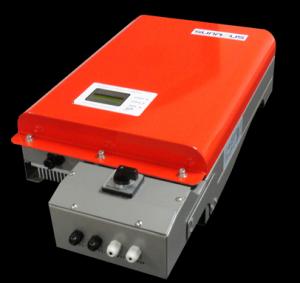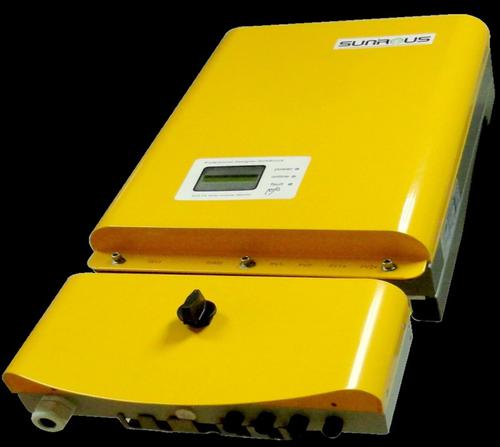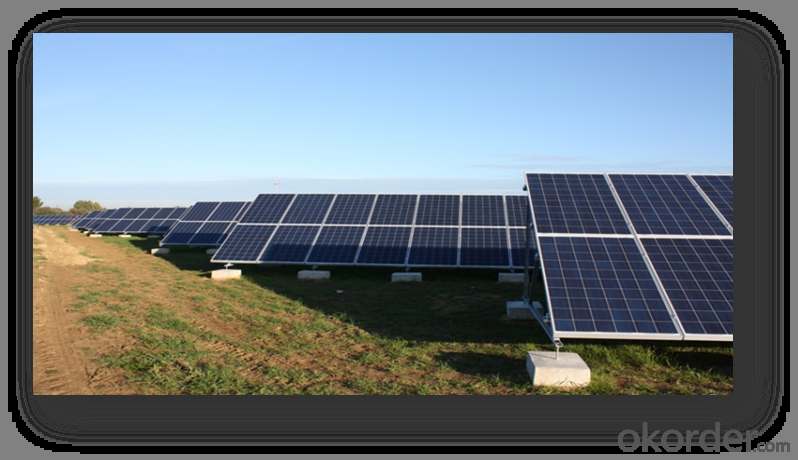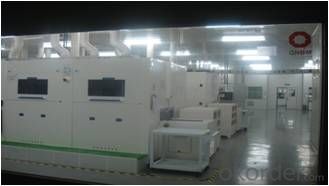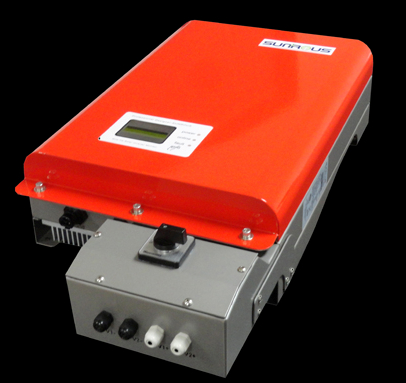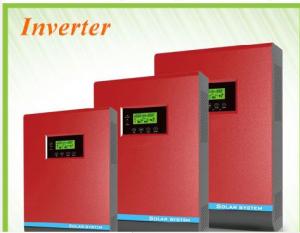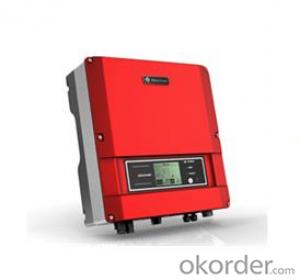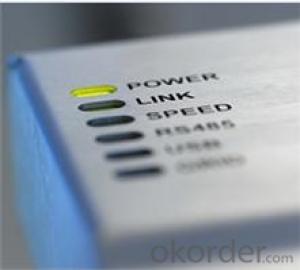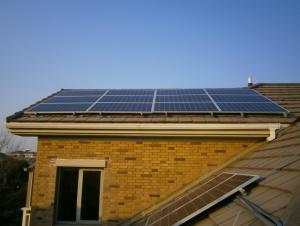1800 Watt High Frequency Transformer Isolation PV Grid-Tied Inverter
- Loading Port:
- Shanghai
- Payment Terms:
- TT or LC
- Min Order Qty:
- 100 mm
- Supply Capability:
- 1000 mm/month
OKorder Service Pledge
OKorder Financial Service
You Might Also Like
characteristics:
5 years warranty
· Sealing stainless steel shell, suitable for indoor or outdoor installation
· High frequency transformer isolation
· The highest effciency achieves 98%
· Wide input Voltage range
· Adopt connectors type cable connection, Easy operation and installation
· Best tracking effciency with OptiTrac MPP control
· operating temperature range -25 ℃ to + 55℃
· High reliability due to complete protection function
· Anti-theft protection
· Plug-in grounding
HF series 1.5kw — 5.0kw
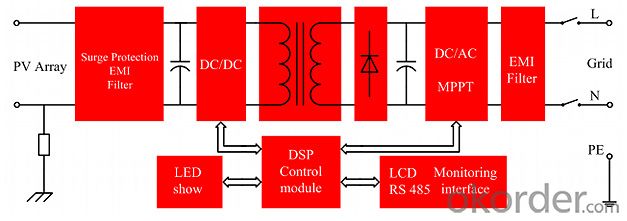
High frequency transformer isolation is the main feature of our production, which make Installation easier due to the reduced weight and higher conversion effciency because of omitting Low frequency transformer. The wide input voltage range from 180 to 600volt gives you extraordinary fexibility for you system design. Not need to set graphic display and RS485 communication system make the devices highly user-friendly.
This product can by multi-level parallel combination for 6kw to 20kw needed any power grade HF series technical parameter.
parameters:
GT1.5-ZX-01/HF | GT2.0-ZX-01/HF | GT2.5-ZX-01/HF | GT3.0-ZX-01/HF | GT4.0-ZX-01/HF | GT5.0-ZX-01/HF | |
Input(DC) | ||||||
Max.DC Power | 1600W | 2100W | 2650W | 3150W | 4200W | 5200W |
Max.DC Voltage | 600V | |||||
PV Voltage range, MPPT | 150V ~ 550V | 150V ~ 550V | ||||
Max.input current | 10.0A | 14.0A | 16.0A | 20.0A | 25.0A | 30.0A |
Number of MPP trackers | 1 | |||||
Max.number of strings (parallel) | 1 | 1 | 2 | 2 | 3 | 3 |
Output(AC) | ||||||
Nominal AC power / | 1500W | 2000W | 2500W | 3000W | 4000W | 5000W |
Max.output current | 13.0A/7.0A | 17.0A/9.0A | 21.0A/12.0A | 25.0A/14.0A | 21.0A | 30.0A |
Nominal AC Voltage / range | 102-138Vac/180-264Vac | 180-270Vac | ||||
AC grid frequency / range | 47.5-51.5Hz / 59.3-60.5Hz | |||||
Power factor at rated power | 1 | |||||
THD | < 3% | |||||
AC connection | Single-phase | |||||
Efficiency | ||||||
Max. efficiency/Californian efficiency | > 98.0% / > 97.0% | |||||
MPP adaptation efficiency | > 99.0% | |||||
Protection devices | ||||||
DC reverse polarity protection | √ | |||||
AC short-circuit protection | √ | |||||
Ground fault monitoring | √ | |||||
Grid monitoring | √ | |||||
Output Transient Voltage Suppression | √ | |||||
Over load | √ | |||||
Anti-islanding | √ | |||||
General data | ||||||
Dimensions (W/ H / D) in mm | 350 / 560 / 160 | 370 / 540 / 185 | ||||
Weight(Kg) | 16 | 19 | 23 | |||
Operating temperature range | -25 ~ +60℃ | |||||
Storage temperature range | -40 ~ +70℃ | |||||
Ambient humidity | 0 ~ 100% | |||||
Consumption (night) | < 0.5W | |||||
Topology | HF-transformer galvanic isolation | |||||
Cooling concept | Convection | |||||
Enclosure type | IP65 / NEMA 3R | |||||
Features | ||||||
DC connection: PV special connector | √ | |||||
AC connection: connector | √ | |||||
LCD display & Backlit | √ | |||||
LED display | √ | |||||
Interfaces: RS485 | √ | |||||
Warranty: 10 years | √ | |||||
Certificates & approvals | G83 / G59 / TUV / SAA / ETL / JET/ CE | |||||
certificates:
The Australian SAA certification

Q1 : What is you advantages
A1:
a).We are professional ups manufacturer for more than ten years and we have these staffs with rich
production and R&D
b) Excellent workers and skilled engineers
c).Our aims are to provide every customer high quality, reasonable price and excellent
service.
d)we can guarantee to send the goods on time. And also accept any transportation ways that
you require
Q2 : How do you control the production quality
A2:
a) For materials, we have IQC departments and the IQC testing follow MIL-STD-105E standard
b) in production have 4 times function testing
c) all of our products with 100% burn-in testing
d) 100% QC testing before delivery
Q3 : Do you accept OEM/ODM?
A3 : ODM&OEM are warmly welcomed !!!
- Q: How do you connect solar panels to a solar inverter?
- To connect solar panels to a solar inverter, you need to follow a few steps. First, ensure that the solar panels are properly installed and positioned to receive maximum sunlight. Then, connect the positive and negative terminals of each solar panel in series or parallel, depending on the system design. Next, connect the positive and negative terminals of the solar panel array to the input terminals of the solar inverter. Finally, double-check all connections and wiring to ensure they are secure and tight.
- Q: Can a solar inverter be integrated with a smart home system?
- Yes, a solar inverter can be integrated with a smart home system. Many modern solar inverters have built-in communication capabilities, such as Wi-Fi or Ethernet, which allow them to connect to a smart home system. This integration enables homeowners to monitor and control their solar power production and energy consumption conveniently through a centralized smart home platform. They can track energy production, set energy usage preferences, and even automate certain functions based on available solar power.
- Q: What is maximum power point tracking (MPPT) in a solar inverter?
- The technique known as maximum power point tracking (MPPT) is employed in solar inverters for the purpose of optimizing the power output of a photovoltaic (PV) system. When solar panels are exposed to sunlight, they generate electricity, but the amount of power they produce can vary depending on factors such as temperature, shading, and the angle at which sunlight strikes them. The maximum power point (MPP) is the specific point at which a solar panel generates the greatest amount of power given the prevailing environmental conditions. However, because these conditions are constantly changing, it is crucial to continuously track the MPP in order to ensure that the solar panels achieve the highest possible power output. Solar inverters equipped with MPPT functionality employ advanced algorithms and electronics to continuously monitor the voltage and current output of the solar panels. By dynamically adjusting the operating voltage and current to align with the MPP, the MPPT inverter ensures that the solar panels operate at their most efficient, regardless of how the environmental conditions may change. When the solar panels are functioning at their MPP, the MPPT inverter extracts the maximum amount of power from the panels and converts it into usable AC power. This optimization leads to increased overall energy generation and maximizes the return on investment for solar power systems. In addition to enhancing efficiency, MPPT also provides other advantages. It can compensate for fluctuations in solar irradiation, temperature, or shading that might impact the power output of the panels. By continually tracking the MPP, the MPPT inverter adjusts the operating parameters to minimize the impact of these factors, ensuring a consistent and optimal power output. In summary, MPPT is a critical feature in solar inverters as it maximizes the power output of a PV system by continuously tracking and adjusting the operating parameters to align with the MPP. This technology enables solar power systems to operate at their highest efficiency, enhance energy generation, and maximize the benefits of utilizing renewable energy sources.
- Q: How does a solar inverter handle temperature variations?
- A solar inverter is designed to handle temperature variations by incorporating advanced thermal management systems. These systems ensure that the inverter operates within a specified temperature range, typically between -25 to 60 degrees Celsius. The inverter uses internal fans, heat sinks, and sometimes liquid cooling mechanisms to dissipate heat generated during operation. Additionally, the inverter may have temperature sensors that monitor the internal and external temperatures, allowing it to adjust its performance and efficiency accordingly. This temperature management enables the solar inverter to operate optimally and maintain its reliability even in extreme temperature conditions.
- Q: What is the role of a solar inverter in grid management and stability?
- The role of a solar inverter in grid management and stability is crucial in integrating solar power into the existing electrical grid system. Solar inverters are responsible for converting the direct current (DC) electricity generated by solar panels into alternating current (AC) electricity that can be used by homes and businesses or fed back into the grid. In terms of grid management, solar inverters play a vital role in maintaining the stability and reliability of the electrical grid. They provide grid support functions such as voltage regulation, frequency control, and reactive power compensation. By monitoring the grid conditions and adjusting the output of solar power accordingly, inverters help to balance the supply and demand of electricity in real-time, ensuring grid stability. Solar inverters also contribute to grid stability by improving power quality. They actively filter out harmonics, voltage fluctuations, and other electrical disturbances that can be caused by the intermittent nature of solar power generation. This ensures that the electricity generated by solar panels is of high quality and does not introduce any disruptions or damage to the electrical grid. Furthermore, solar inverters enable the seamless integration of solar power into the grid, allowing excess energy to be fed back into the system. This is known as net metering or feed-in tariff programs, where solar energy producers can receive compensation for the surplus electricity they produce. With the help of inverters, the generated solar energy can be efficiently transferred to the grid, reducing the reliance on traditional fossil fuel-based power generation and promoting renewable energy integration. Overall, the role of a solar inverter in grid management and stability is to ensure the smooth integration and optimal utilization of solar power, while maintaining the stability, reliability, and quality of the electrical grid. It acts as a bridge between solar energy producers and the grid, facilitating the efficient and sustainable integration of renewable energy sources into the existing power infrastructure.
- Q: Can a solar inverter be used in a hybrid solar system?
- Yes, a solar inverter can be used in a hybrid solar system. A hybrid solar system combines both solar energy and another source of energy, such as a battery or grid power. The solar inverter is responsible for converting the DC (direct current) power generated by the solar panels into AC (alternating current) power that can be used to power the electrical devices in a home or business. In a hybrid solar system, the solar inverter can still perform this function, allowing the system to utilize solar energy while also being able to draw power from other sources when needed.
- Q: What is the role of a DC-DC converter in a solar inverter?
- The role of a DC-DC converter in a solar inverter is to convert the direct current (DC) power produced by the solar panels into the appropriate voltage and current levels required to feed into the alternating current (AC) grid. This conversion ensures efficient power transfer from the solar panels to the electrical grid, enabling the solar energy to be used for various applications or to be stored in batteries.
- Q: What is the role of a solar inverter in protecting the electrical grid?
- The role of a solar inverter in protecting the electrical grid is to convert the direct current (DC) electricity produced by solar panels into alternating current (AC) electricity that is compatible with the grid. It ensures that the solar power generated is synchronized with the grid's voltage and frequency, allowing for seamless integration and preventing any disruptions or voltage fluctuations that could potentially harm the grid. Additionally, solar inverters have built-in safety mechanisms such as anti-islanding protection, which disconnects the solar system from the grid during a power outage, ensuring the safety of utility workers who may be working on the grid. Overall, solar inverters play a crucial role in ensuring the stability, reliability, and safety of the electrical grid when incorporating solar energy.
- Q: Are there any disadvantages of using a solar inverter?
- Yes, there are a few disadvantages of using a solar inverter. Firstly, solar inverters are sensitive to extreme temperature variations, and their efficiency can be affected in very high or low temperature conditions. Secondly, solar inverters require regular maintenance and occasional replacement, which adds to the overall cost of the system. Additionally, solar inverters produce a small amount of electromagnetic interference (EMI) which can interfere with nearby electronic devices if not properly shielded. Lastly, solar inverters are grid-tied systems, meaning they rely on a stable electrical grid to function. In case of power outages or grid malfunctions, solar inverters may shut down and stop supplying power to the connected devices.
- Q: Can a solar inverter be used with different types of solar PV systems (roof-mounted, ground-mounted, etc.)?
- Different types of solar PV systems, such as roof-mounted, ground-mounted, and other variations, can utilize a solar inverter. The primary function of a solar inverter is to convert the direct current (DC) electricity produced by solar panels into alternating current (AC) electricity. This converted electricity can be used to power appliances and can also be fed into the electrical grid. The conversion process remains consistent regardless of the type of PV system being used. However, it's crucial to consider that the solar inverter's requirements and specifications may differ depending on the type of PV system. Different PV systems may have varying voltage and power outputs, which may necessitate specific inverter models capable of handling these requirements. For instance, ground-mounted solar systems may have larger arrays and higher power outputs than roof-mounted systems, requiring a different type of inverter. Hence, while a solar inverter can generally be used with various types of solar PV systems, it is essential to select an inverter that is compatible with the specific system's voltage, power output, and other technical specifications. It is always advisable to consult with a professional solar installer or technician to ensure the appropriate selection and installation of the solar inverter for your particular PV system.
Send your message to us
1800 Watt High Frequency Transformer Isolation PV Grid-Tied Inverter
- Loading Port:
- Shanghai
- Payment Terms:
- TT or LC
- Min Order Qty:
- 100 mm
- Supply Capability:
- 1000 mm/month
OKorder Service Pledge
OKorder Financial Service
Similar products
Hot products
Hot Searches
Related keywords
